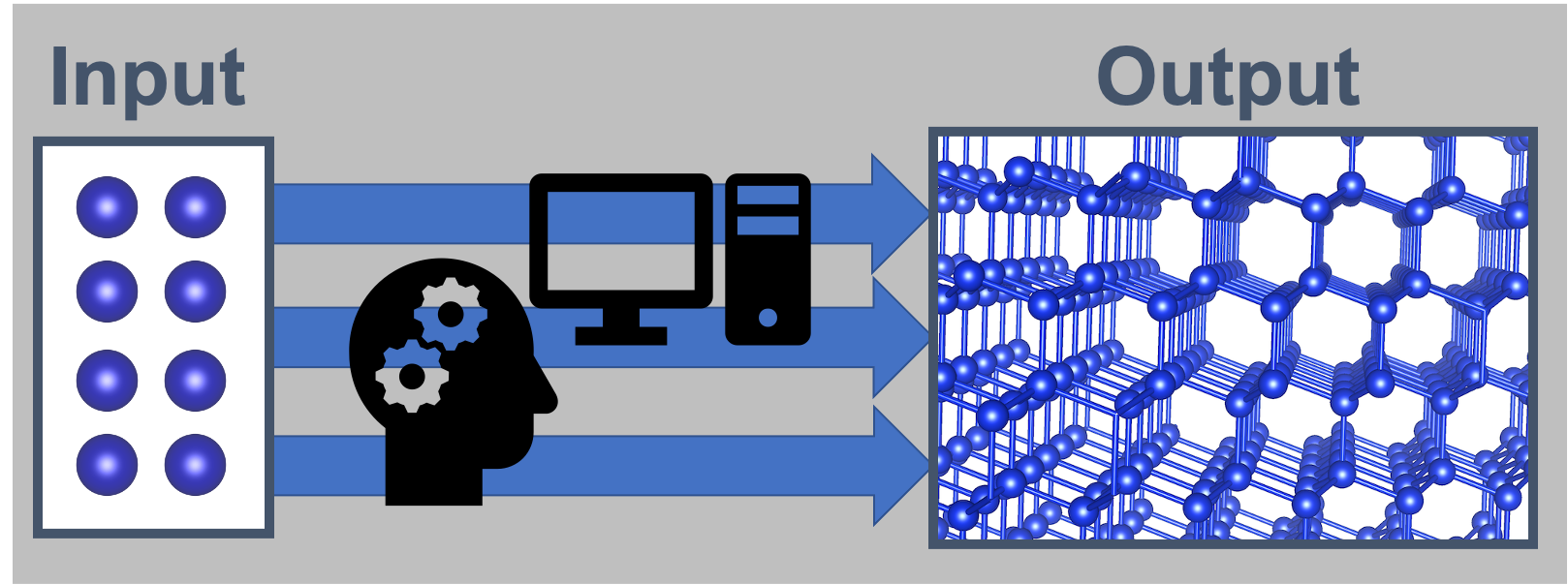
Document
CrySPY (pronounced as crispy) is a crystal structure prediction tool written in Python.
CrySPY automates the following:
- Structure generation
- Submitting jobs for structure optimization
- Collecting data for structure optimization
- Selecting candidates using machine learning
CrySPY can be install by pip install csp-cryspy.
Latest version
CrySPY 1.4.3 (2025 October 6)
News
- [2025 October 6] CrySPY 1.4.3 released. Version information/version 1.4.3
- Bug fix in EA-vc
- [2025 July 18] CrySPY 1.4.2 released. Version information/version 1.4.2
- Supports VASP and QE for EA-vc
- Priority order of structure optimization input file names
- Job file auto-rewriting
- cryspy-skip subcommand
- cryspy-calc-convex-hull subcommand
- [2025 July 7] CrySPY 1.4.1 released. Version information/version 1.4.1
- add_max, elim_max, and subs_max in EA-vc
- Charge neutral condition in EA-vc
- cryspy-Eplot subcommand
- [2025 June 17] CrySPY 1.4.0 released. Version information/version 1.4.0
- Variable-composition evolutionary algorithm
- Interactive mode
- [2024 May 31] CrySPY 1.3.0 released. Version information/version 1.3.0
- There are important changes. See version information.
- [2024 May 10] CrySPY 1.2.5 released. Version information/version 1.2.5
- Bug fix
- [2024 May 7] (Document) FAQ page
- [2024 May 7] CrySPY 1.2.4 released. Version information/version 1.2.4
- Bug fix
- [2024 April 24] (Document) Tutorial > Random Search (RS) > VASP
- [2023 October 21] CrySPY 1.2.3 released. Version information/version 1.2.3
- Bug fix for MPI
- [2023 October 18] CrySPY 1.2.2 released. Version information/version 1.2.2
- Enthalpy
- [2023 September 27] CrySPY 1.2.1 released. Version information/version 1.2.1
- Bug fix for ASE interface
- [2023 August 8] (Document, Utility) Upload the example of CHGNET
- [2023 July 10] CrySPY 1.2.0 released. Version information/version 1.2.0
- Interface for ASE
- Adoption of logging
- [2023 June 14] CrySPY 1.1.1 released. Version information/version 1.1.1
- bug fix
- [2023 May 16] CrySPY 1.1.0 released. Version information/version 1.1.0
- MPI parallelization (optional)
- New score of LAQA
- [2023 March 16] CrySPY 1.0.0 released. Version information/version 1.0.0
- CrySPY is available in PyPI, so you can install by pip.
Discussions
Discussions in GitHub (questions and comments)
License
CrySPY is distributed under the MIT License
Copyright (c) 2018 CrySPY Development Team
Code contributors
- Tomoki Yamashita and Lab members (Nagaoka University of Technology)
- Nobuya Sato (National Institute of Advanced Industrial Science and Technology)
- Hiori Kino (National Institute for Materials Science)
- Kei Terayama (Yokohama City University)
- Hikaru Sawahata (Kanazawa University)
- Shinichi Kanehira (Osaka University)
Reference
- CrySPY(software)
- T. Yamashita, S. Kanehira, N. Sato, H. Kino, H. Sawahata, T. Sato, F. Utsuno, K. Tsuda, T. Miyake, and T. Oguchi,
“CrySPY: a crystal structure prediction tool accelerated by machine learning”,
Sci. Technol. Adv. Mater. Meth. 1, 87 (2021). Link
- T. Yamashita, S. Kanehira, N. Sato, H. Kino, H. Sawahata, T. Sato, F. Utsuno, K. Tsuda, T. Miyake, and T. Oguchi,
- Bayesian optimization
- T. Yamashita, N. Sato, H. Kino, T. Miyake, K. Tsuda, and T. Oguchi,
“Crystal structure prediction accelerated by Bayesian optimization”,
Phys. Rev. Mater. 2, 013803 (2018). Link - N. Sato, T. Yamashita, T. Oguchi, K. Hukushima, and T. Miyake,
“Adjusting the descriptor for a crystal structure search using Bayesian optimization”,
Phys. Rev. Mater. 4, 033801 (2020). Link
- T. Yamashita, N. Sato, H. Kino, T. Miyake, K. Tsuda, and T. Oguchi,
- Bayesian optimization and evolutionary algorithm
- T. Yamashita, H. Kino, K. Tsuda, T. Miyake, and T. Oguchi,
“Hybrid algorithm of Bayesian optimization and evolutionary algorithm in crystal structure prediction”,
Sci. Technol. Adv. Mater. Meth. 2, 67 (2022). Link
- T. Yamashita, H. Kino, K. Tsuda, T. Miyake, and T. Oguchi,
- LAQA
- K.Terayama, T. Yamashita, T. Oguchi, and K. Tsuda,
“Fine-grained optimization method for crystal structure prediction”,
npj Comput. Mater. 4, 32 (2018). Link - T. Yamashita and H. Sekine,
“Improvement of look ahead based on quadratic approximation for crystal structure prediction”,
Sci. Technol. Adv. Mater. Meth. 2, 84 (2022). Link
- K.Terayama, T. Yamashita, T. Oguchi, and K. Tsuda,
